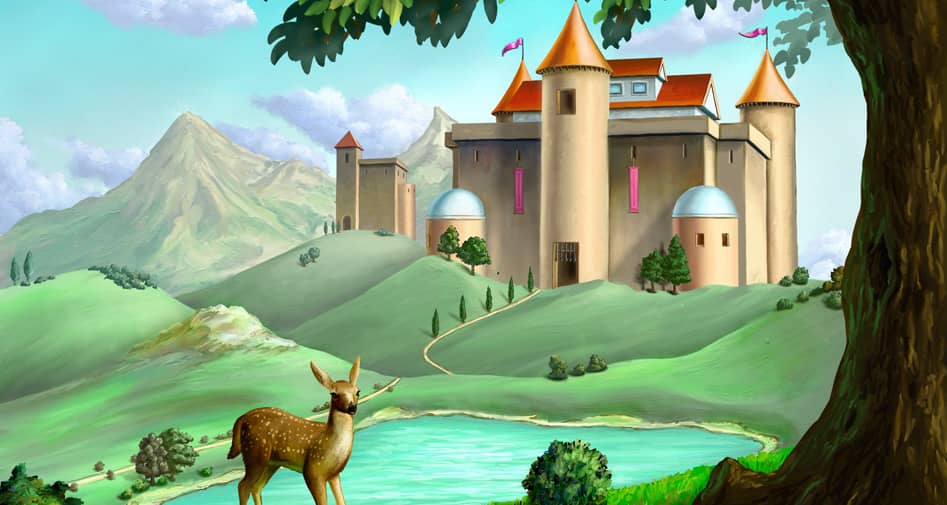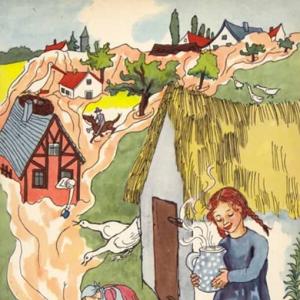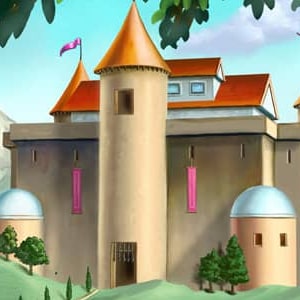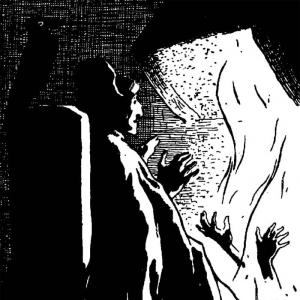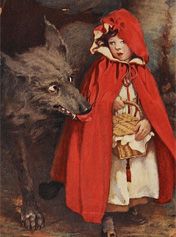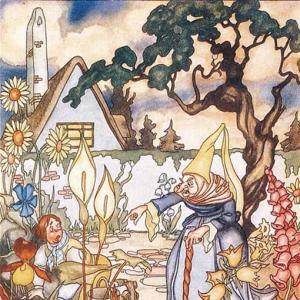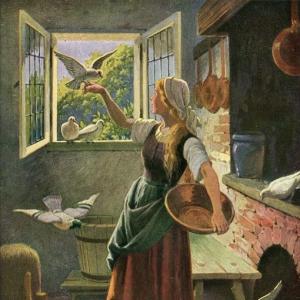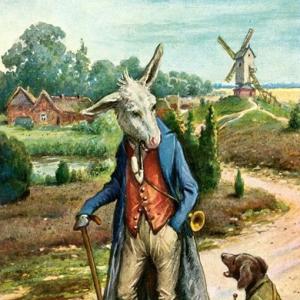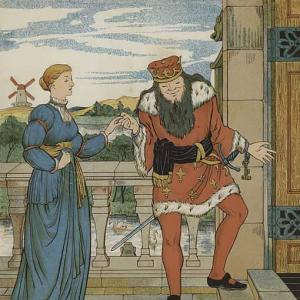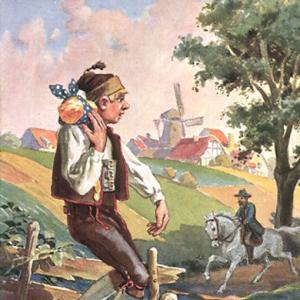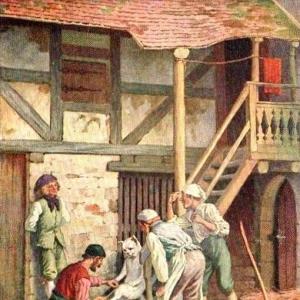Reading time for children: 25 min
There was a little sea fish of good family, the name of which I don’t remember. That the more learned will have to tell you. This little fish had eighteen hundred brothers and sisters, all the same age. They didn’t know their father or mother, so they had to care for themselves and swim about on their own, but that was a lot of fun. They had plenty of water to drink – the entire ocean. They didn’t think about their food. That was sure to come their way. Each did as he pleased; each would have his own story, but then none of them thought about that.
The sun shone down into the water, making it light and clear. It was a world full of the strangest creatures, some of them enormously big, with great, horrible mouths that could sallow all the eighteen hundred brothers and sisters, but none of them thought about that, either, for none of them had ever been swallowed.
The little ones swam together, close to one another, as the herring and the mackerel swim. As they were swimming along at their best and thinking of nothing in particular, there sank from above, down into the midst of them, with a terrifying noise, a long, heavy thing which seemed to have no end to it; further and further it stretched out, and every one of the small fish that it struck was crushed or got a crack from which he couldn’t recover. All the fishes, the small and the big as well, were thrown into a panic. That heavy, horrible thing sank deeper and deeper and grew longer and longer, extending for miles – through the entire ocean. Fishes and snails, everything that swims, everything that creeps or is driven by the currents, saw this fearful thing, this enormous unknown sea eel that all of a sudden had come from above.
What kind of thing was it? Yes, we know! It was the great telegraph cable that people were laying between Europe and America.
There were great fear and commotion among all the rightful inhabitants of the ocean where the cable was laid. The flying fish shot up above the surface as high as he could, and the blowfish sped off like a gunshot across the water, for it can do that; other fishes went to the bottom of the ocean with such haste that they reached it long before the telegraph cable was seen down there, and they scared both the codfish and the flounder, who lived peacefully at the bottom of the ocean and ate their neighbors. A couple of the starfish were so frightened that they turned their stomachs inside out, but in spite of that they lived, for they can do that. Many of the lobsters and crabs got out of their fine shells and had to leave their legs behind.
In all this fright and confusion, the eighteen hundred brothers and sisters had all become separated, never again to know or even meet each other, excepting ten of them who had remained at the same place; and after these had held themselves still for a couple of hours, they recovered from their first fright and began to be curious. They looked about. They looked up and they looked down, and there in the deep they thought they saw the frightful thing that had scared them, scared everyone, big and little. There it lay along the bottom of the ocean, extending as far as they could see. It was quite thin, but then they didn’t know how thick it could make itself or how strong it was. It lay very quiet, but that, they thought, could be a trick.
„Let it lie where it is! It doesn’t concern us,“ said the most cautious of the little fish.
But the very smallest one of them insisted on gaining some knowledge as to what that thing might be. It had come down from above, so above one could best find out about it.
And so they swam up to the surface, where there was calm weather. There they met a dolphin, which is a sort of jumping jack, an ocean rover, that can turn somersaults in the water. As these have eyes to see with, he must have seen what had happened and should know all about it. They inquired, but the dolphin had only been thinking of himself and his somersaults, had seen nothing, and didn’t know what to answer, so he kept quiet and looked proud.
Thereupon they turned to the seal who had just ducked down. He was more polite, although seals eat small fishes, for today he had had his fill. He knew a little more than the dolphin.
„Many a night I have rested on a wet rock and looked far inland, miles away from here. There live some sneaky creatures who, in their language, are called people. They plot against us, but often we slip away from them, which I know how to do, and that is what the sea eel has done, too. He has been in their power, up there on the earth, for a long, long time, and from there they carried him off on a ship, to bring him across the ocean to a distant land. I saw what trouble they had, but they could manage him, because he had become weak on the earth. They laid him down in coils and circles. I heard how he ‚ringled‘ and ‚rangled‘ when they put him down, but still he got away from them. They held on to him with all their might; many hands held fast, but still he slipped away from them and reached the bottom. There he lies now, for a while at least, I think.“
„He is rather thin!“ said all the little fish.
„They have starved him,“ said the seal, „but he will soon be himself again, fat and big around. I suppose he is the great sea serpent that people are so afraid of and talk so much about. I had never seen him before and never believed he existed, but now I do; I’m sure he’s the sea serpent!“ And with that the seal dove down.
„How much he knew! How much he talked!“ said all the little fish. „We have never been so enlightened before! If only it isn’t all a lie!“
„We could swim down and investigate,“ said the smallest fish. „On the way, we can hear what others think about it.“
„We’re not going to move a fin to find out anything more!“ said the others, and swam away.
„But I’m going to,“ said the smallest, and plunged down into deep water.
But the little fish was a considerable distance from the place where „that long sunken thing“ lay. He looked and searched in a direction down in the deep water. Never before had he imagined the world to be so big. The herring swam in great masses, each school of them shining like a mighty boat of silver. The mackerel also swam together and looked even more magnificent. There were fishes of all shapes and with markings in all colors. Jellyfish, like half-transparent flowers, simply lay back and let the currents carry them along. Great plants grew up from the bottom of the ocean, as did fathom-high grass and palm-shaped trees, every leaf beset with shining shellfish.
At last the little fish saw a long, dark streak way down and swam toward it; but it was neither fish nor cable. It was the gunwale of a large sunken vessel, the upper and lower decks of which had been broken in two by the force of the ocean. The little fish swam inside, where the many people who had perished with the sinking of the ship had since been washed away, except for two – young woman lay stretched out with a little child in her arms. The water rocked them to and fro, and they seemed to be asleep. The little fish became quite frightened, for he didn’t know that they never again could awaken. Seaweed hung like cultivated foliage over the rail above the fair forms of mother and child. It was so quiet there, so lonely. The little fish hurried away as fast as he could, out to where the water was clearer and there were fishes to see. He hadn’t gone far when he met a young and terribly large whale.
„Don’t swallow me!“ said the little fish. „I’m so small that I’m not even a tiny bite, and it’s a great pleasure for me to live!“
„What do you want way down here, where your kind never comes?“ asked the whale.
So the little fish told of the strange long eel, or whatever that thing was, which had sunk and scared even the most courageous of ocean creatures.
„Ho, ho!“ said the whale, and drew in such a lot of water that he had to make an enormous waterspout when he came to the surface for a breath. „Ho, ho!“ he said, „so that was the thing that tickled my back when I turned around! I thought it was a ship’s mast that I could use for a back-scratcher! However, it wasn’t in this location; no, that thing is much farther out. I’ll investigate it, though. I have nothing else to do.“
And so he swam forth, the little fish following, but not too close, for there would be a powerful stream where the big whale shot through the water.
They met a shark and an old sawfish. These two had also heard of the strange sea eel that was so long and thin. They hadn’t seen it, but they wanted to.
Then a catfish appeared. „I’m coming with you!“ he said, and took the same course. „If the great sea serpent isn’t thicker than a cable, then I’ll bite it in two with one bite!“ And he opened his mouth and showed his six rows of teeth. „I can bite dents in a ship’s anchor, so I can easily bite through that stem!“
„There it is!“ said the big whale. „I can see it!“ He thought he saw better than the others. „See how it rises, see how it sways, bends, and curves!“
However, this was not the sea serpent, but an exceptionally large eel, who was many yards long, and came closer.
„I’ve seen him before,“ said the sawfish. „He’s never made much fuss in the ocean here or frightened any big fishes.“
And so they talked to him about the new eel and asked if he wanted to join them on their voyage of discovery.
„If that eel is longer than I,“ said the sea eel, „then something unfortunate will happen.“
„That it will!“ said the others. „There are enough of us not to have to tolerate it.“ And then they hurried along.
But now, directly in their way, there appeared a strange monster, bigger than them all. It looked like a floating island that could not hold itself up. It was a very old whale. His head was overgrown with seaweed, his back beset with barnacles and so many oysters and mussels that his black skin was entirely covered with white spots.
„Come along, old fellow,“ they said. „A new fish has come that we will not tolerate!“
„I’d rather lie where I am,“ said the old whale. „Leave me in peace. Let me lie. Oh, my, oh, my! I suffer from a dreadful sickness. The only relief I have is when I go up to the surface and get my back above it. Then the big, nice birds come and pick at me, and that feels so good, as long they don’t drive their beaks in too far; often they go right into my blubber. Just see for yourself! There is a complete skeleton of a bird stuck in my back. That bird struck his claws in too deep and couldn’t get loose when I went down to the bottom. Now the little fishes have eaten him. Just see how he looks, and how I look! I have a sickness!“
„That’s just imagination!“ said the other whale. „I am never sick. No fish is sick!“
„I beg your pardon!“ said the old whale. „The eel has a skin disease, the carp has smallpox, and all of us have intestinal worms!“
„Nonsense!“ said the shark, and didn’t care to hear more; nor did the others. They had something else to do.
Finally, they came to the place where the telegraph cable lay. It had a very long resting place indeed at the bottom of the ocean, from Europe to America, over sandbanks and sea mud, rocky formations and sea-plant wilderness, and, yes, entire forests of coral. The currents down there change, and whirlpools twist around; fishes crowd each other and swim in flocks greater than the countless multitudes of birds that people see when birds of passage are in flight. There are a commotion, a splashing, a humming, and a rushing; a little of that rushing still remains to haunt the big, empty conch shells when we hold them to our ears.
Yes, now they came to the place.
„There lies the animal!“ said the big fishes, and the little one said so, too.
They saw the cable, its beginning and end beyond their horizon. Sponges, polyps, and seaweed swayed from the ground, rising and falling over the cable, so that now it was hidden and then visible again. Sea porcupines, snails, and worms moved over it. Gigantic spiders, with whole fringes of vermin on them, crawled along the cable. Dark-blue „sea sausages,“ or whatever the creatures are called that eat with their entire bodies, lay beside it and smelled this new animal that had come down to lie at the bottom of the ocean. Flounders and codfish turned about in the water, in order to hear what was said from all sides. The starfish, who could hold himself down in the mud and keep his eyes outside, lay and stared to see what would come of all this confusion. The telegraph cable lay motionless. But life and thought were in it; human thoughts went through it.
„That thing is cunning,“ said the whale. „It’s able to hit me in the stomach, and that’s my weak point!“
„Let’s feel our way,“ said a polyp. „I have long arms. I have limber fingers. I have touched it. Now I’ll feel it a little more firmly.“ And then he stretched his longest and most flexible arms down to the cable and around it. „It has no scales!“ said the polyp. „It has no skin! I don’t believe it will ever bear young ones!“
The sea eel laid down alongside the telegraph cable and stretched himself as far as he could. „That thing is longer than I am!“ he said. „But it isn’t length that counts. One must have skin, stomach, and flexibility! The whale – that is, the young, strong whale – dove down deeper than he ever had been. „Are you a fish or a plant?“ he asked the cable. „Or are you only some piece of work from above that can’t thrive down here among us?“
But the telegraph cable didn’t answer. It had no means of contacting anyone at such a location. Thoughts were going through it, people’s thoughts, which in a single second were heard from land to land, many hundreds of miles apart.
„Will you answer, or do you want to be broken?“ asked the fierce shark, and all the other big fishes asked the same. „Will you answer, or do you want to be broken?“
The cable didn’t move, but it had its own private thoughts, which it had a right to have, considering that it was filled with other’s thoughts. „Let them break me. Then I’ll be hauled up and put in order again – that has happened to others of my kind who were in shallower waters.“ And so it didn’t answer. It had something else to do. It telegraphed and thereby did its just duty at the bottom of the sea.
Up above, the sun was going down, as people say. It blazed like the reddest fire, and all the clouds in the heavens glowed with a fiery hue, each more magnificent than the other.
„Now we’re getting the red lighting,“ said the polyps, „and we may be able to see the thing better, if necessary.“
„At it! At it!“ shouted the shark, showing all his teeth.
„At it! At it!“ said the swordfish, and the whale, and the sea eel. They rushed forward, the shark leading, but just as he was about to bite the cable, the swordfish, out of pure anxiety, ran his saw right into the back of the shark. That was a great mistake, and the shark had no strength left to bite. Everything became muddled in the mud. Big fishes, little fishes, „sea sausages,“ and snails ran into one another, ate each other – clashed and gnashed. The cable lay still and attended to its own business, as one should do.
The dark night brooded above; but in the ocean the millions and millions of small living creatures lighted it. Crawfish, not even as big as a pinhead, gave out light. It is quite wondrous, but now that’s the way it is.
The ocean creatures looked at the telegraph cable. „What is that thing, and what isn’t it?“ Yes, that was the question.
Presently an old sea cow appeared. People call these mermaids or mermen. This one was a she, and had a tail and two short arms to splash with. She wore seaweed and parasites over her breasts and head, and she was proud of this.
„Are you seeking knowledge and wisdom?“ she said. „I am the only one who can give you this; but in return I demand that you guarantee safe pasturage on the bottom of the ocean for me and mine. I am a fish like you are, but I am also a crawling animal, through practice. I am the wisest in the ocean. I know about everything that moves down here and about all that goes on up above. That thing you are pondering over is from above, and whatever falls down from up there is dead, or will be dead, and powerless; let it lie there for what it is. It’s only a man-made invention.
„I believe there is more to it than that!“ said the little fish.
„Hold your tongue, mackerel!“ said the big sea cow.
„Stickleback!“ said the others, and that was even more insulting.
And the sea cow explained further to them that this alarming thing, which, as a matter of fact, hadn’t uttered a single sound, was in its entirety nothing more than some new device from the dry land, and she delivered a little lecture about people’s deceitfulness. „They want to catch us,“ she said; „that’s all they live for. They stretch out nets for us, and come with bait on hooks to tempt us. That thing there is some sort of big string that they think we are going to bite. They are so stupid! But we are not! Don’t touch that junk. In time it will unravel and all turn to dust and mud. Everything that comes from up there cracks and breaks – is good for nothing!“
„Good for nothing!“ said the other ocean creatures, and held onto the sea cow’s opinion, so as to have an opinion.
The little fish, however, had his own thoughts. „Perhaps that enormously long, thin serpent is the most wonderful fish in the ocean. I have a feeling it is.“
„The most wonderful,“ say we humans, too, and we say it with knowledge and assurance.
The great sea serpent has long been the theme of song and story. It was conceived and born by man’s ingenuity and laid on the bottom of the ocean, stretching from the eastern to the western lands, and carrying messages as swiftly as light flashes from the sun to our earth. It grows, grows in power and length, grows year after year, through all oceans, around the world. It is beneath the stormy seas and the glass-clear waters, where the skipper, as if sailing through transparent air, looks down and sees crowds of fishes resembling many -colored fireworks.
Deepest down of all lies the outstretched serpent, a blessed Midgard snake, which bites its own tail as it encircles the earth. Fishes and other sea creatures clash with it. They do not understand that thing from above. People’s thoughts rush noiselessly, in all languages, through the serpent of science, for both good and evil. The most wondrous of the ocean’s wonders is our time’s.
 Learn languages. Double-tap on a word.Learn languages in context with Childstories.org and Deepl.com.
Learn languages. Double-tap on a word.Learn languages in context with Childstories.org and Deepl.com.Backgrounds
Interpretations
Linguistics
„The Great Sea Serpent“ by Hans Christian Andersen is a fantastical fairy tale that explores the effect of human technological advancements on the natural world, told from the perspective of sea creatures. The story is centered around the laying of the transatlantic telegraph cable—an engineering marvel of the 19th century that connected Europe and America, enabling instant communication across vast distances.
In the fairy tale, the sea creatures, including a little fish protagonist and other underwater dwellers, witness the descent of the telegraph cable into the ocean with great fear and curiosity. To them, it appears as a massive, mysterious sea serpent that disrupts their peaceful lives and causes chaos and confusion. They debate what the object might be, with the wise sea cow concluding it must be another trick from humans, while the little fish maintains a persistent curiosity and openness to understanding it.
Through this narrative, Andersen cleverly uses the animals‘ interpretations to comment on humanity’s intrusion into the natural world. The tale addresses themes of curiosity, fear of the unknown, and the potential for misunderstanding between different worlds. The great sea serpent symbolizes not only the marvels of human invention but also the potential disruptions and disconnections it can create with the natural environment. Andersen emphasizes the limitations of the creatures‘ understanding while suggesting a broader view of the telegraph cable as a remarkable achievement of human intellect and innovation.
Ultimately, Andersen’s fairy tale can be seen as both a celebration of human progress and a cautionary tale about respecting the natural order and the mysteries of the world. By weaving together elements of fantasy with real technological advancements, he crafts a story that remains relevant in discussions about technology’s impact on the environment and the importance of coexistence with nature.
„The Great Sea Serpent“ by Hans Christian Andersen is a thought-provoking tale that cleverly intertwines a classic narrative with themes of progress and the unknown impact of human advancements on nature. It cleverly uses the metaphor of the great sea serpent—a manifestation of the transatlantic telegraph cable—to explore different perspectives on technological development and its impact on both nature and society.
Technological Progress vs. Nature: The telegraph cable represents technological advancement, a product of human innovation that intrudes upon the natural world. The sea creatures‘ fear and confusion can be seen as an illustration of nature’s initial reaction to human interference and the struggle for coexistence. This interpretation highlights the tension between preservation of the natural world and the march of progress.
Perspective and Understanding: The diverse reactions of the sea creatures, from curiosity to fear to outright aggression, suggest varying levels of understanding and acceptance of change. The little fish, who seeks knowledge and is open-minded, contrasts with the dismissive attitude of others, such as the sea cow. This can reflect the theme of how different societies and individuals react to new ideas, technology, and change.
Human Ingenuity and Communication: The telegraph cable symbolizes the human desire to connect across vast distances, to bridge gaps and foster communication. It suggests that while technology is a powerful tool for progress and understanding between people, it can also be perceived as a threat by those who do not understand it. The cable’s presence in the ocean, carrying human thoughts rapidly across continents, represents both literal and metaphorical connections.
Fear of the Unknown: The tale illustrates a primal fear of the unknown. As the creatures encounter the cable, they project their fears and assumptions onto it, culminating in chaos. This reflects how fear, shaped by ignorance and misunderstanding, can lead to irrational behavior, a commentary on human tendencies when faced with the unfamiliar.
Symbol of Unity and Conflict: The cable acts as a unifying force, connecting lands and people with a shared purpose, but it also creates division and conflict beneath the sea. This duality can be a comment on how human advancements, while beneficial, often have unforeseen consequences that can disrupt existing ecosystems and challenge existing structures.
In conclusion, „The Great Sea Serpent“ is a layered story that can be read as an allegory for the complex relationship between technology, nature, and society. It invites reflection on themes of progress, the pursuit of knowledge, and the responsibility that comes with innovation.
The fairy tale „The Great Sea Serpent“ by Hans Christian Andersen provides a rich canvas for linguistic and thematic analysis.
Here’s a breakdown of its key elements
Narrative Voice: The story is told in the third person, which is typical of fairy tales. This allows for an omniscient perspective, offering insights into the thoughts and feelings of various sea creatures. Direct speech is frequently used, enabling character development and advancing the story through dialogue between different marine animals.
Descriptive Language: Andersen uses vivid imagery to create a sense of wonder and curiosity. Words like „strangest creatures,“ „enormous unknown sea eel,“ and „transparent flowers“ evoke a fantastical underwater world. The contrast between the known and unknown is emphasized through the juxtaposition of familiar sea life with the mysterious telegraph cable.
Metaphor and Symbolism: The telegraph cable is metaphorically presented as a „great sea serpent. “ This reflects the human tendency to mythologize new and incomprehensible technology. Sea creatures symbolize different human attitudes towards technology and the unknown—curiosity, fear, skepticism.
Repetition: Repetitive phrases such as „Ho, ho!“ and „At it!“ create rhythm and build tension as various fish react to the cable.
Use of Anthropomorphism: Sea creatures are given human traits. The seal speaks politely, the old whale complains of sickness, and the sea cow lectures, attributing human behaviors and emotions to marine life.
Thematic Elements
Fear of the Unknown: The tale explores the theme of fear generated by ignorance and misunderstanding. The sea creatures‘ reaction to the cable reflects natural fear towards the unknown and innovative.
Technology and Progress: The telegraph cable is a symbol of human progress and the rapidly advancing technology of Andersen’s time. It represents connectivity, knowledge, and the dual nature of scientific advancement—both wondrous and intimidating.
Nature vs. Human Innovation: There is an underlying tension between the untouched natural world and human intervention. The cable changes the marine environment, causing both disruption and fascination among sea creatures.
Community and Individuality: The behavior of the fish school, often moving as one, suggests societal norms and collective behavior. In contrast, the smallest fish embodies individuality and curiosity, venturing alone to seek understanding.
Enlightenment vs. Ignorance: The tale contrasts enlightenment and ignorance, both among the sea creatures and humans. The little fish represents the pursuit of knowledge, while others are content with their assumptions.
Conclusion
„The Great Sea Serpent“ intricately weaves linguistic elements to enhance its exploration of technology, knowledge, and fear. Andersen’s fairy tale, while grounded in its 19th-century context of burgeoning telegraphy, remains relevant today as a reflection on how humanity grapples with technological advancement and the mysteries of the natural world.
Information for scientific analysis
Fairy tale statistics | Value |
|---|---|
| Translations | DE, EN, DA, ES, IT |
| Readability Index by Björnsson | 25.4 |
| Flesch-Reading-Ease Index | 84 |
| Flesch–Kincaid Grade-Level | 4.9 |
| Gunning Fog Index | 7.3 |
| Coleman–Liau Index | 8.4 |
| SMOG Index | 7.9 |
| Automated Readability Index | 4.6 |
| Character Count | 18.633 |
| Letter Count | 14.221 |
| Sentence Count | 259 |
| Word Count | 3.464 |
| Average Words per Sentence | 13,37 |
| Words with more than 6 letters | 416 |
| Percentage of long words | 12% |
| Number of Syllables | 4.472 |
| Average Syllables per Word | 1,29 |
| Words with three Syllables | 172 |
| Percentage Words with three Syllables | 5% |
